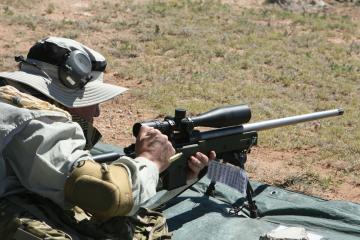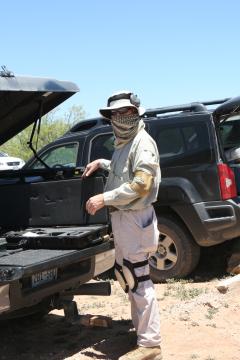Comments from Competitor John Sternberg


John Sternberg racks a round out of his 6.5x47 Lapua rifle during the Long-Range Side Match on Friday.
This was my first trip to the Blue Steel Ranch and I hope it is the beginning of several more trips
in the future. This is one awesome match. Carry 100 to 200 ounces of water and drink it all in the
five to six hours you are out being humbled. Then be prepared to drink even more when you get back
to the base. If you are not in good to great shape then perhaps benchrest is your sport. This is not
a venue for the weak or for someone with gear that does not run. We did have some shooters go home
due to the heat, wind and dust conditions and others left because of gear problems.
If you think you are a good (or better) shooter then join us in the variable winds (10 to 35+ MPH)
and variable terrain (steep inclines and declines) and varied shooting positions (not all prone on
flat ground!). If you think that doping the wind is easy and that your data card does not matter


Sternberg demonstrates his strategy for staying safe in the brutal, hot sun of the New Mexico desert.
then you should stay home. Your gear - make sure it works and can withstand the harsh conditions? A
little dust in your chamber, bolt, magazine, nose and other open crevices and orifices will make you
think twice about what you should be carrying and wearing and how much the heat matters to you and
your gear.
As to the competition there are always better shooters that will show you how to get your hits. The
quality of the gear and experience of the better shooters makes the trip worthwhile, even if you are
paying $4 for a gallon of gas (or more for diesel!).
I have been shooting the Sporting Rifle Match at the Whittington Center for the past few years. This
is a great training ground for the BSR but does not compare in terms of the match format or
difficulty. Quality optics, range finders and binoculars are a requirement to compete in either
venue. I learned why most of the shooters used binoculars with a range finder --- they
work better than using separate devices to first locate the hidden targets and then find them again
with a range finder. At least half of my missed targets were due to failure to locate the hanging
steel. The monocular range finder (I used the Swarovski) was a clear disadvantage to finding a
target when compared to my Zeiss binoculars.
Lastly, be certain that you use enough Ballistic Coefficient (BC) and velocity. BC does matter
greatly in variable winds and provides more room for errors. Velocity helps you cheat the speed of
wind along with the higher BCs when shooting long range targets. Be certain of your zero and that
you can shoot one-half MOA because anything less is a waste of time and money. Next year I hope to
shoot better than 50% misses and 50% hits